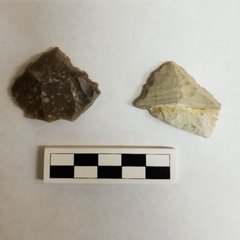During the excavations around the Church and Long Barrack, two possible gunflints were recovered.
These two are made of two different types of chert (also called flint). Both possible gunflints are not as nice looking as many others that have been recovered from the site during previous excavations.
The lighter one still exhibits the cortex of the chert/flint stone, on the outer part of the stone. Although not common, other gunflints have been encountered around San Antonio that exhibit the cortex. One recovered during the excavations at San Francesco di Paola Catholic Church, one possible location of Mission Valero, produced a gunflints in 2014 that also exhibited the cortex.
The rectangular shape, although not common, has been encountered at different sites in San Antonio. It appears to have an area on one of the edges that looks like the gunflints was used.
The darker one has one edge completely knocked off and another edge shows signs of hammer striking. This gunflints appears to have a more traditional square-shape, but due to the hammer impacts, the shape is altered.
Often, the origin of the gunflints can be determined by the type of chert used and the shape. Bulkier gunflints were most likely manufactured by the Spanish, whereas French-made gunflints often manufactured a finer, honey-colored chert. English versions were typically manufactured from a grey to brownish-black chert that is not local to the region.
It is possible that these were both locally made gunflints using chert that can be found near the site due to the colors and shapes of the items. Gunflints such as these could have been made during the Mission Period and into the time of the Battle of the Alamo.
Flintlock firearms began to see a decline in use from the 1830s, and were almost entirely replaced, or converted, by the 1860s.



